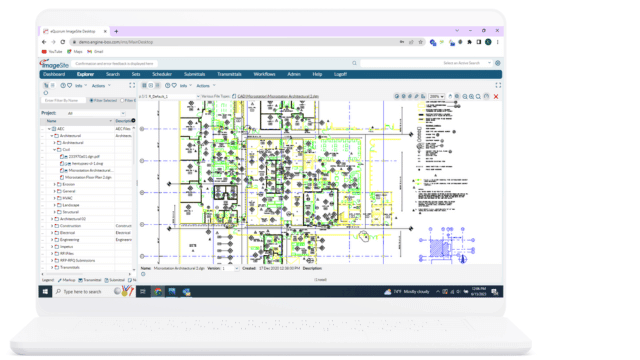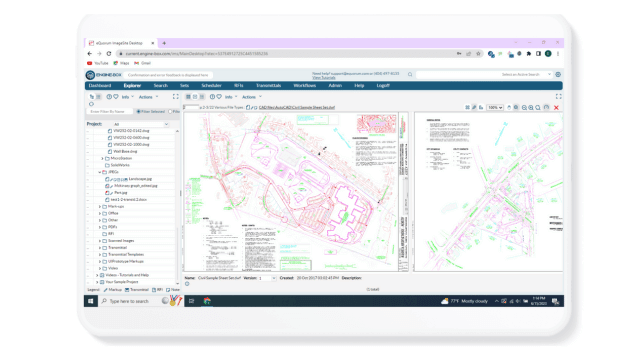The Discipline of Workflow Schedule Management
The Discipline of Workflow Schedule Management
Are you aware that the discipline of workflow schedule management leads to elevated performance and productivity? Keep reading.
Business operations seemed more chaotic than ever. The economic swings seem bigger; the labor pool is tighter, more diverse, and more geographically dispersed; the amount of information is enormous; and at the end of the day management has just become darn harder. Trying to get your arms around all that’s going on and ensuring the organization is focused on getting the tasks done is now more complex and daunting. Add pandemics, supply chain disruptions, geopolitical uncertainty, and now even historical inflation. What is a manager to do?
Keeping Everyone’s Eye on the Prize
Project work typically consists of functional teams completing tasks towards the accomplishment of the plan. Whether this is engineering products, producing products, designing facilities, engineering facilities, constructing facilities, paying invoices, or training employees. These are all projects that comprise different functions acting in a coordinated manner to move the company forward.
Knowing the objective and motivating all the moving parts in a coordinated fashion has never been easy, whether in the battlefield, sports field, or on the business floor. Add the distractions and information deluge presented to employees today and it’s easy to believe keeping projects “tight” and completing them on time can be very trying.
Micromanagement Versus Freedom Management
There is a spectrum of management approaches used to oversee and motivate organizational efforts. Managers have exercised detailed, focused micromanagement through to hands-off laissez-faire tactics. The effectiveness of previous approaches, especially when overseeing organizational workflows, differs considerable. But the constant has, until most recently, been the management of corporate employees who resided in, or mostly resided in, a business office. This has changed.
Remote workers have added another variable in the management caldron. Keeping the pieces together now requires additional skills, including scheduling and operating through virtual meetings, considerably more telephone and text communications, and reliance on secure access to centralized company systems.
While many employees have viewed this as additional freedom and as productivity enhancement, it’s requiring a slightly different management process to ensure project and workflow progress and completion.
Yet More Management Challenges
Adding to management complexity have been uncertainties in supply chain operations and performance and the availability of applicable staffing. Not having required resources and assets when needed, or trained staff, complicates workflow management, forcing managers to reform historical processes, schedules, and even responsibilities.
These new processes and employee responsibilities, can, unfortunately, add yet another layer of concern – greater human error. Making decisions on the fly, without sufficient resources or knowledge often leads to bad decision-making. Trying to meet organizational milestones in a new or different environment doesn’t necessarily increase errors but it does reduce the confidence levels of those decisions. The less confidence, the greater probability of errors.
So, what are Managers to Do?
The current sub-optimal environment requires a slightly different approach to getting daily processes performed effectively and on schedule. We call this “management by guardrail.” As we figure out the new management landscape, especially with the increased involvement of participants working from home, the management oversight of major workflows needs to change to a greater sense of pushing processes back to the “line” as deviations, delays, modifications, and resource change outs occur. Though not much different than before, where managers could meet with individuals and supervisors on a daily basis for updates and possible course changes, these reviews are now often done virtually.
By consistently nudging the process back to normal, workflows can continue to be managed towards successful and timely outcomes. The issue is knowing when the process is significantly deviating and in need of corrective actions. Good managers know when to address these issues from experience, data, and interactions with key workflow participants. It is just harder now, given all the new variables and the changing environment.
Technology Can Help
Better focused organizations have moved to systems to aid them in designing, monitoring, managing, reporting, and analyzing processes and workflows. Using a workflow management solution to execute on these organizational workflows provides managers with real benefits that are more helpful today than ever.
Robust workflow management systems offer, at a minimum, the following capabilities and benefits:
- Definition of participant roles and the ability to assign individuals to those roles at any time during the execution of the workflow
- Definition of task requirements such that participants are clear what efforts are needed to be completed and opportunities to reach out to other workflow participants online, for further clarification
- Identification of a clear schedule, with milestones and dates and times, with an easy option to escalate or reprioritize tasks and with notifications to all relevant participants when the workflow is falling behind or is likely to miss a deadline
- Inclusion of all needed files, data, and information for participants to complete their jobs, reducing the time and effort required to track down needed resources
- Audit trails of all actions taken and completed by each participant with the ability to reconstruct the workflow progress for process improvement initiatives
- Online and email notifications automatically generated by the system to alert participants of workflow changes, priority escalations, scheduled due dates, and other relevant workflow items
- Commenting and markups to documents to allow for a continuum of discussion that is both documented and helpful in providing context and perspective to the current workflow issues
- Approval management and routing for both documents and tasks.
Even More Intangible Benefits
Establishing and work with a formal workflow management system not only has the above benefits but more intangible benefits that can accrue to the organization. Foremost, is the formal process of defining workflow tasks at a granular level. As they say, the devil is in the details and unless managers think through workflow details the execution is bound to go awry, or at a minimum, surprise project and process managers.
Organizations that work with well thought-out, detailed workflows always have better execution outcomes, meet schedules more frequently, and can review and improve existing procedures and policies more easily.
Part of these details are the identified schedules, milestones, and due dates associated with workflows. The mere visibility of milestones and due dates is a motivator to many participants, as moving towards dates provides a focus and goal. Plus, visibility of milestones to all workflow participants enables better collaboration, and, in many cases, the offer to assist fellow employees that are falling behind or who may not be able to complete their assignments in time.
Experience also shows that providing collective attention on workflow tasks and milestones increases on-time completion rates, as well as the quality of the performed efforts (the old “heat and light” principle). Teams always execute better when working together towards common, known objectives.
Disciplined Workflows Come with a No Excuses Attachment
With workflows thought out and detailed, with participants appropriately identified, and with workflow tasks and projects adequately specified, participants don’t have any excuses as to not being able to execute per schedule. Especially for remote workers, where not being in the office presents the opportunity to say they were not aware of needed steps or did not have access to needed data and files. Having a formal workflow management solution available to all users, regardless of their location, removes these excuses.
The “I didn’t know” excuse becomes more difficult when the entire workflow is laid out for all participants to view, comment on, add to, and report against. The impact of missing a task or step deadline is also very visible so employees see their affect on overall performance and how much their work matters in the bigger picture.
Give People Flexibility but Make Sure They Know the Workflow
Managers love to be flexible and give their team discretion on how and when they should get their job done. Most people just know what they are supposed to do and when they need to complete it. But as workflows get more complex, more workers are at home, more supply chain disruptions occur, managers are facing more deviations from plan, often causing delays, rework, miscommunications, and frustration.
If the team understand the workflows, can visually see them, can understand their impact to overall performance, and have an easy way to communicate with other participants, these deviations can be minimized and mitigated. Simply being disciplined in executing key workflows leads to elevated performance and productivity.
Additional EDMS Features
Our EDMS solutions
ImageSite and EngineBox are eQuorum’s robust workflow and document management solutions, created to help workers manage their essential workflows while maintaining complete control over their engineering files and documents. Not only do they provide a secure collaboration site for workers, but they also help organizations manage document distribution with third parties like vendors, contractors, and customers. Both systems are offered at a competitive price, enabling organizations to get a quick return on their investment by providing the features and functionality needed to help organizations improve efficiency, productivity, and collaboration. Companies can choose from concurrent user subscriptions or named user subscriptions, ensuring organizations have subscription options that make sense for their business.

ImageSite®
Our single source engineering workflow and document management system. Built in HTML5 so there is no software to deploy to client computers or mobile apps to download. Offered as an On-premise or Private Cloud system.
EngineBox™
EngineBox is a cloud based workflow and document management version of ImageSite that resides outside the corporate network.
Our EDMS solutions
ImageSite and EngineBox are eQuorum’s robust workflow and document management solutions, created to help workers manage their essential workflows while maintaining complete control over their engineering files and documents. Not only do they provide a secure collaboration site for workers, but they also help organizations manage document distribution with third parties like vendors, contractors, and customers. Both systems are offered at a competitive price, enabling organizations to get a quick return on their investment by providing the features and functionality needed to help organizations improve efficiency, productivity, and collaboration. Companies can choose from concurrent user subscriptions or named user subscriptions, ensuring organizations have subscription options that make sense for their business.

EngineBox™
EngineBox is a cloud based workflow and document management version of ImageSite that resides outside the corporate network.
The eQuorum Customer Promise
In 2005, eQuorum developed the first all browser-based EDMS. The system, although for on-premise use, was still created to remove client software and JAVA from user computers and allow users to have a single viewer based on the simple navigation functionality of browsers. Today, eQuorum provides that same application in a private Cloud or a SaaS Cloud option. We can do this because we are, and have always been, browser-based, understanding the enhanced speed, security, and usability of this technology.
With the abundance of document management systems on the market today, there’s no doubt that choosing the right Cloud document management software can be a difficult decision. eQuorum is here to provide a comprehensive, powerful, and most importantly – affordable Cloud document management solution. We believe in providing real value to our customers by eliminating unnecessary costs, providing industry-leading functionality, and equipping your team with the right tools using cutting edge technology to bring your products to market faster.
eQuorum®
We specialize in engineering workflow and document management. Our comprehensive, yet easy-to-use software provides the solution to manage data from design to manufacturing and production, to sales, support and administration.